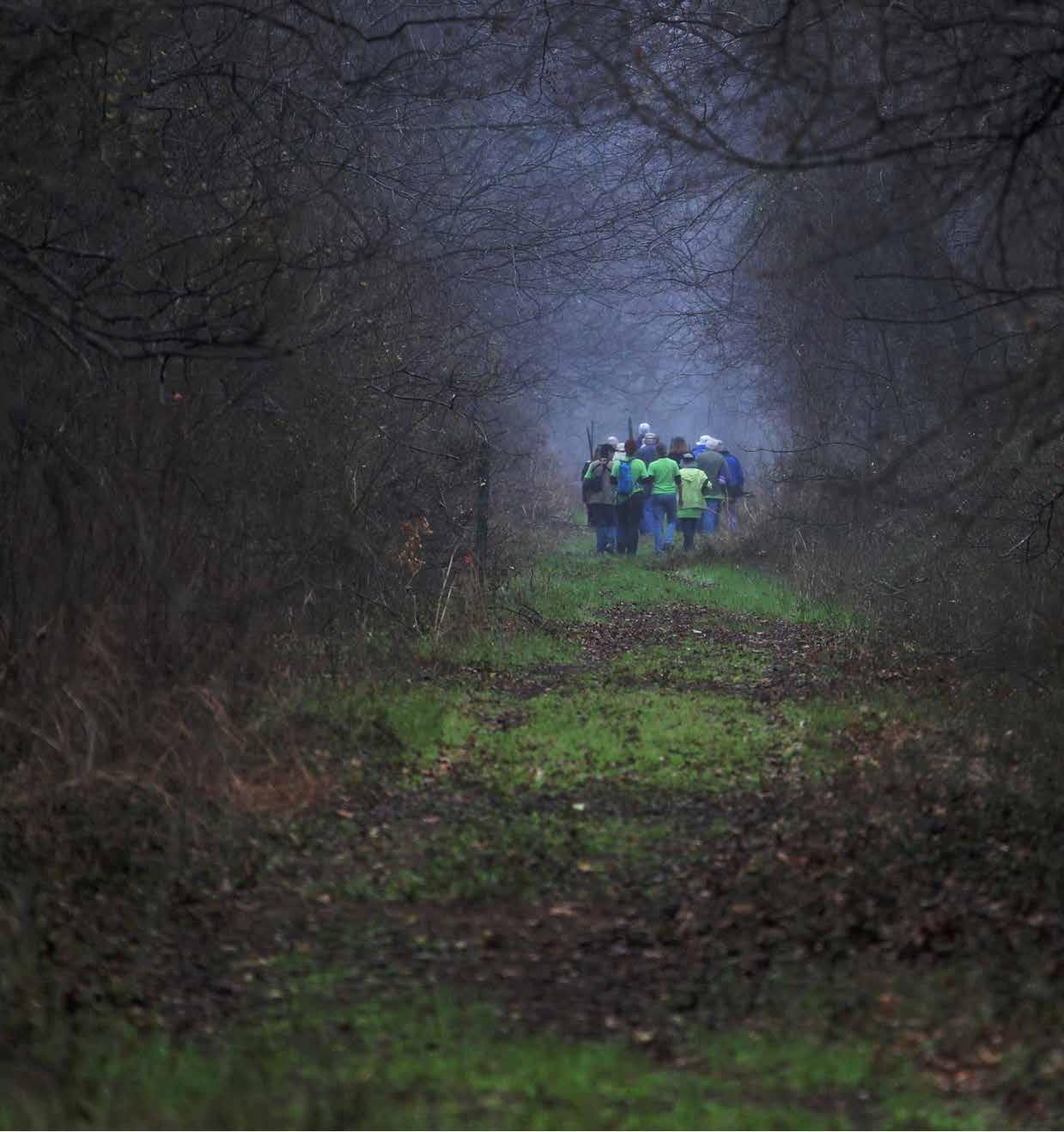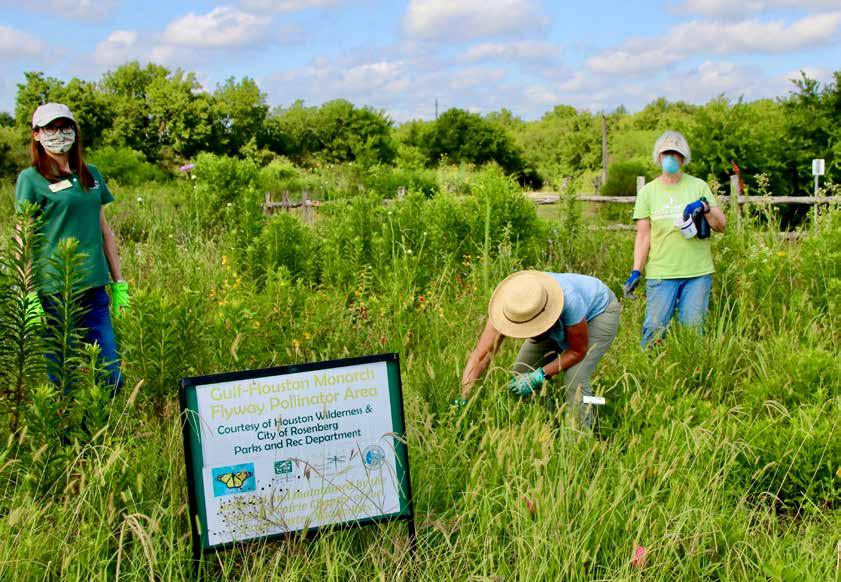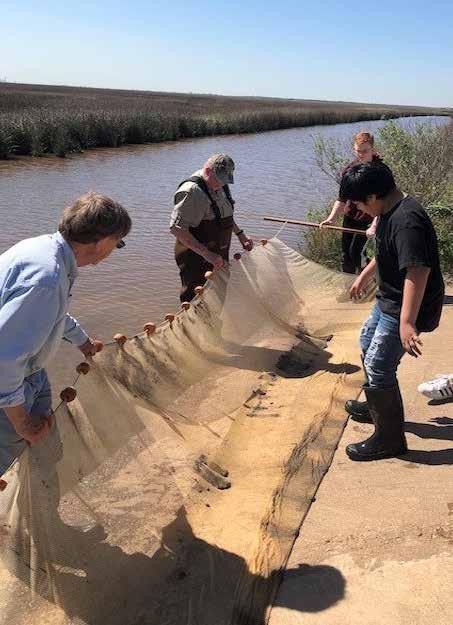
11 minute read
Texas Master Naturalists
Getting Dirty for Conservation
Article by LORIE A. WOODWARD
Texas Master Naturalists get dirty on behalf of conservation—and multiply the outreach efforts of the Texas Parks and Wildlife Department and Texas A&M AgriLife Extension Service.
“Recognizing conservation is a big job in a big, diverse state like Texas, TPWD and AgriLife founded the Texas Master Naturalist program 22 years ago,” said Mary Pearl Meuth, Assistant State Coordinator of the Texas Master Naturalist program. “The founders knew we needed more hands on deck.”
Since its inception, the program has trained 13,000 people to do the handson work of conservation, education and technical guidance. On any given year, there are about 6,000 active Texas Master Naturalist volunteers. As a point of comparison, TPWD has about 3,500 fulltime employees and AgriLife Extension has about 1,350 full-time employees including management, administration and other “non-field” positions.
On average the Texas Master Naturalist corps contributes about 450,000 hours back to the state each year. Some volunteers complete their required 40 hours of service, while others give back 1,000 hours or more.
“In human resource department terms, 1,000 hours is the equivalent of a part-time employee,” Meuth said. “We have several volunteers who have achieved a 20,000hour milestone, which is incredible considering Texas Master Naturalist has only been around for 22 years.”

Barron Rector, state Extension range specialist, instructing Coastal Prairie New Training Class Members at Attwater Refuge, 2017.

Pollinator Protectors, Coastal Prairie Chapter at work.
The statewide program is organized into local chapters that encompass single county or multi-county areas. Currently, 48 chapters, covering about 80 percent of Texas, exist; two more are in development and expected to launch in 2021.
“It’s a ‘learn here, give here’ model,” Meuth said. “We want our volunteers to know what is in their backyards, so they can identify, manage and conserve the local resources—and reach out to their neighbors who share the same environment.”
To become a Master Naturalist, volunteers complete at least 40 hours of combined classroom and field training in all aspects of conservation.
“We cover everything from ecoregions, soil, water and weather to the ‘-ologies’—mammalogy, herpetology, ichthyology and even geology,” Meuth said. “We also tackle management practices that bring conservation down to the landscape level.”
Many people are initially drawn to the organization to gain knowledge.
“A desire to learn about nature is what hooks most people,” Meuth said.
BECOMING—AND STAYING— A TEXAS MASTER NATURALIST
Contact your local chapter either through the AgriLife Extension office or through the Texas Master Naturalist website (txmn.tamu.edu).
Determine when the chapter is offering training, which is a minimum of 40 hours of combined classroom/virtual and field experience. Training fees range from $25-$125, depending on the local chapter.
Take the training. (This may be the most challenging part because most chapters only host training once a year. If you miss the annual session, you will have to wait until the next cycle.)
Upon training conclusion, engage in local chapter projects and log at least 40 volunteer hours each year.
To remain active, complete 8 hours of advanced training each subsequent year.
She likens the learning experience to drinking knowledge from a fire hose while tumbling down Alice in Wonderland’s rabbit hole.
“Once you fall into the Master Naturalist’s rabbit hole, you’re gone,” Meuth said. “You suddenly have unlimited access to this huge network of naturalists—and every question and its answer leads to more questions, more curiosity, more classes, more workshops. And the rabbit hole is bottomless because no one ever learns everything about nature.”
While many people come for the knowledge, they stay for the people. Karen L. Aho, president of the Prairie Oaks Chapter, recalled her first encounter with the Master Naturalists. As a non-profit professional, Aho had been invited to speak to the Stephenville-based chapter soon after its founding.
The members introduced themselves. As they began to share their experiences and interests, Aho had a revelation.
“I said to myself, ‘I have found my people,’” said Aho, a native of Pennsylvania who grew up hunting and fishing. “Years later, with people coming and going, I can still say, ‘These are my people.’ The people drawn to Texas Master Naturalist are just my kind of folks.”
In college, she majored in environmental studies and found her dream job as an environmental educator. A move to Texas and a lack of environmental education jobs prompted her to change her career path.
“I joined Texas Master Naturalist as a way to stay in touch with that portion of myself,” Aho said.
Not everyone who comes to the Master Naturalists is a traditional hiker-camper-hunter-angler outdoors enthusiast.
“I’m not a wilderness woman, unless you count gardening in my backyard,” said Martha Cray, president of the Alamo Area Master Naturalists, the state’s original chapter, based in San Antonio.
The retired kindergarten teacher found the program through a friend. Her first encounter involved toddlers, earthworms and storybooks at San Antonio’s Friedrich Wilderness Park, which was also the site of the first Master Naturalist training.
“I thought I was done teaching kids, but seeing their eyes light up lit a fire in me,” Cray said. “It was so fun and rewarding. I tell my friends, you go pull weeds and lead hikes, but give the kids to me.”
Master Naturalists are as diverse as the landscape of Texas. Many are retired from natural resource agencies, corporate offices, higher education, medicine and law. Some people are firsttime landowners eager to learn to care for their own resources.
The corps includes students as young as 18. According to Meuth, the program is enjoying an influx of 20-somethings and 30-somethings who are joining urban chapters as a way to give back to the planet.
“Everybody brings something different to the program, which is what makes it so wonderfully rich and interesting,” Cray said. “We all take our volunteering seriously, but we have such a good time doing it—and our project partners so appreciate our efforts.”
Collegiate chapters are another recent development. According to Aho, whose chapter includes Tarleton State University, students get volunteer experience for their resumes, leadership skill training, mentoring, and a statewide network.

Daddy took me mothing. Photo by Valerie Taber, TMN Rio Brazos Chapter—Best of Show Winning photo in 2020 TMN Annual Meeting photo contest
HOW DO I GET MY LOCAL TEXAS MASTER NATURALIST CHAPTER INVOLVED IN MY PROJECT?
“Our chapters have local autonomy, so the best thing to do is get involved locally. Attend a local meeting. If you have conservation expertise, share it with the group as a speaker. Maybe get trained as a Master Naturalist yourself. Introduce the chapter to your project. Propose a partnership.
The Texas Master Naturalist program is all about building relationships. Build the relationship, build a worthwhile project—remember our volunteers like to put their hands in the dirt on behalf of conservation…they’re not peanut butter sandwich makers—and likely they will come.”
--Mary Pearl Meuth, Assistant State Coordinator, Texas

Floating Dock Work, Coastal Prairie Chapter.
Photo by Garrett Engelbardt
“In Master Naturalists, we’re like one big family of nature nerds,” said Meuth, laughing. “When our students leave their universities and go almost anywhere in Texas, they’ve got a built-in family ready to welcome them.”
As might be expected, the projects are as diverse as the Lone Star State and the volunteers tasked with completing them. The local chapters exist to meet local needs, so there are no-one-sizefits-all volunteer opportunities.
In San Antonio, volunteers work with a host of partners ranging from the San Antonio Parks and Recreation Department to the National Park Service to the San Antonio River Authority to the Witte Museum and many more. As examples of their efforts, they clear hiking trails, battle invasives, plant and maintain pollinator gardens, test water quality, teach children and guide educational walks.
“We’ve got so many places to plug-in,” Cray said. “You don’t even have to like being outside because there are websites to be maintained, books to be balanced and lesson plans to be developed. There’s something for everybody.”
TEXAS MASTER NATURALIST IN THE COVID-19 ERA

When COVID-19 arrived in Texas last March about one-half of the Texas Master Naturalist chapters were in the middle of their annual training programs.
“Chapter leaders quickly came up with new ways to connect at a distance,” said Mary Pearl Meuth, assistant state coordinator for the Texas Master Naturalist program. “The takeaway has been just how innovative the Texas Master Naturalist family is, whether it is in how they communicated or how they adapted their training and their projects to accommodate social distancing and an unprecedented situation.”
As an example, one chapter that is working with landowners to create pollinator gardens and reseed land back to native plants used Facetime to provide technical guidance as the landowners walked their property.
For the first-time, the Texas Master Naturalist staff hosted a virtual Volunteer Fair. The fair was a round-up of digital projects where volunteers could contribute their expertise online. In one instance, Texas Master Naturalists in South Texas contributed their photos and plant identification skills to a range plant website being developed by the AgriLife Extension Range Specialist in Corpus Christi. The fair was so successful that another was held in February 2021.
Like so many organizations, the Texas Master Naturalists moved its five-day annual meeting online in 2020. Staff had four months to transition to a fully digital platform.
“We were building the airplane while we were flying it,” Meuth said.
The results? Attendance doubled to almost 1,200 participants.
“The virtual experience removed the barriers of distance and expense,” Meuth said. “And because the sessions were taped it allowed people who work full time to participate after hours.”
With the goal of keeping volunteers both safe and active, Texas Master Naturalist leaders are watching the progression of COVID-19 as they plan 2021. At the time of this writing, both local trainings and the annual meeting are in flux.
“2021 is a total toss up right now,” said Meuth, noting the organization follows the COVID-19 guidelines prescribed by Texas A&M AgriLife Extension, which are changing almost weekly.
When it comes to local training, some chapters are transitioning to a 100 percent virtual platform. Others are postponing. Staff is preparing a list of all chapters that will be providing training in 2021 and will post it on the statewide website in early 2021.
The Annual Meeting occurs in October. At the moment, staff is deciding what form it might take.
“Our preference is to hold the Annual Meeting in person so we can see our friends and family again, but we also feel strongly that we need to include a virtual component, so those who aren’t able to travel can stay engaged,” Meuth said. “A hybrid approach is most likely, but it’s all yet to be decided.”

Estuary Seining, Cradle of Texas Chapter.
Photo by Kyle Purvis
In the four-county area served by the Prairie Oaks Chapter, volunteers maintain a native prairie demonstration site and a pollinator garden. Some assist at the fish hatchery at Lake Possum Kingdom or as interpretative guides at area state parks. Other people volunteer at community museums. The chapter, in conjunction with the Big Country Chapter based in Abilene, is planning a bio blitz at the 4-H Center in Brownwood.
“One of the big challenges in the non-profit world is having volunteers whose skills meet your organization’s needs,” Aho said. “Master Naturalist is different, though, because we train you well and then ask, ‘So what are you interested in doing?’”
Another thing that sets Master Naturalist apart, according to Cray, is the clear expectations for service and lifelong learning. To remain as an active volunteer, Master Naturalists must contribute at least 40 hours of service annually and complete 8 hours of advanced training.
“You give back to your community and you get back new knowledge that keeps you current, excited and engaged,” Cray said. “Thanks to my mother, I’m a lifelong learner, so new information feeds my enthusiasm.”
From Meuth’s standpoint, the Texas Master Naturalist program continues to thrive and grow because volunteers can see their impact.
“Whether it is butterflies and bees feeding in a pollinator garden or invasive plants disappearing from a native prairie or the light of understanding coming on in a child’s eyes, our volunteers can see their impact over time,” Meuth said. “They and the members of their conservation family are making a difference in their communities and in Texas—and it shows.”
WHY IS TEXAS MASTER NATURALIST A GOOD PARTNER FOR TWA AND CONSERVATION LEGACY?
“Master Naturalists have more passion and drive to learn about Texas’ natural resources than any other group of people across the state. Not to discount the work done by natural resources professionals, but there are Master Naturalists out there that have invested such a tremendous amount of time and energy to learn about our natural world, that they can rival the experts. Not only do Master Naturalists participate in TWA programs to further their education, but there are also those that come to TWA to enhance the education of others—they come to TWA to volunteer. They serve as instructors at youth field days and as Huntmasters for the Texas Youth Hunting Program. They truly are the boots on the ground that stand side by side with the professionals to ensure that conservation education and stewardship continues to permeate Texas and Texans.”
--Kassi Scheffer-Geeslin, Director of Youth Education,










